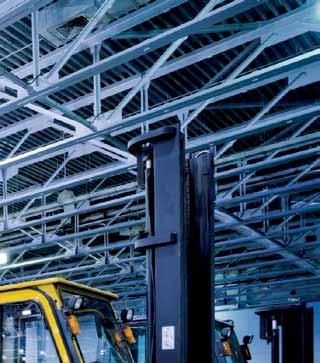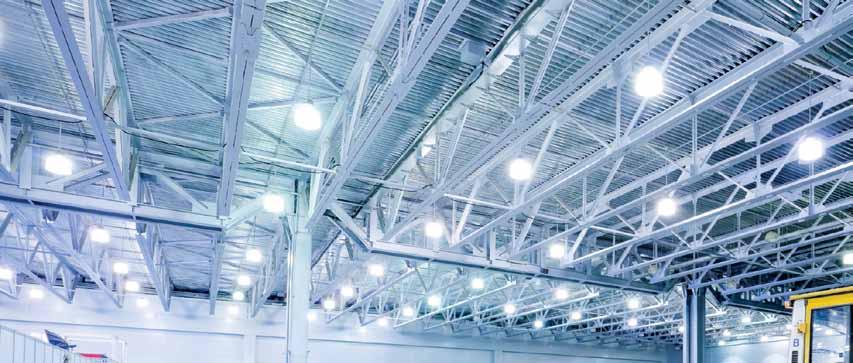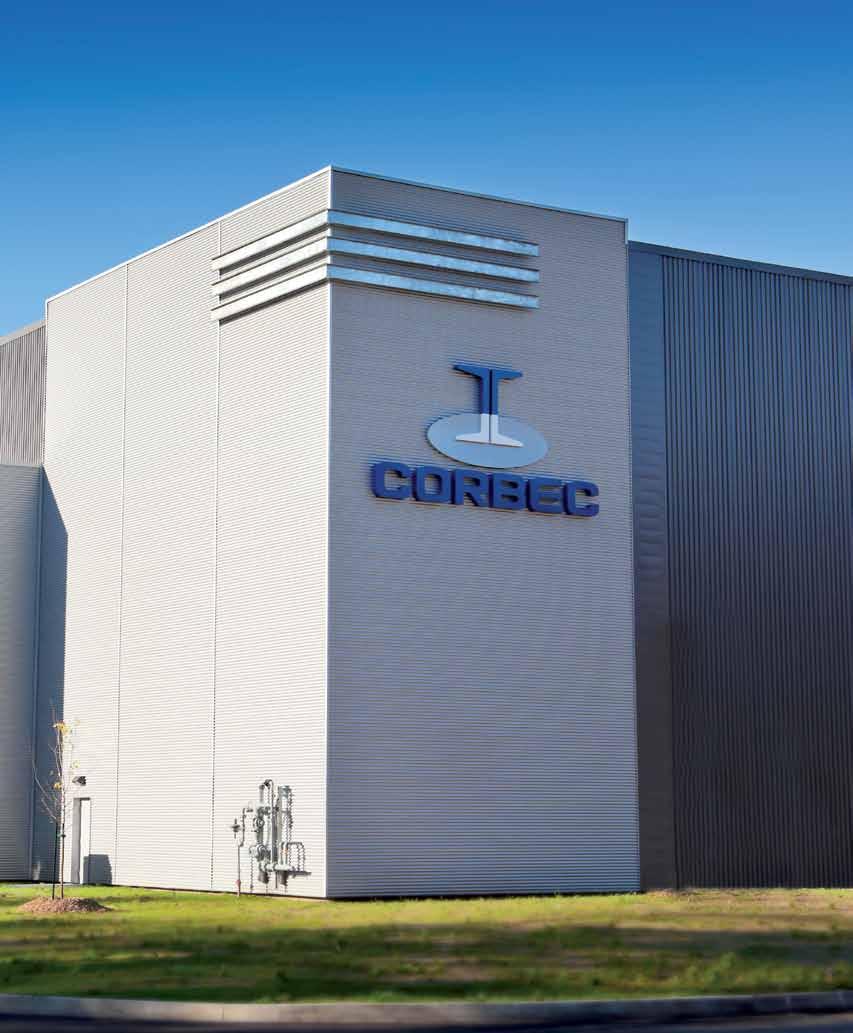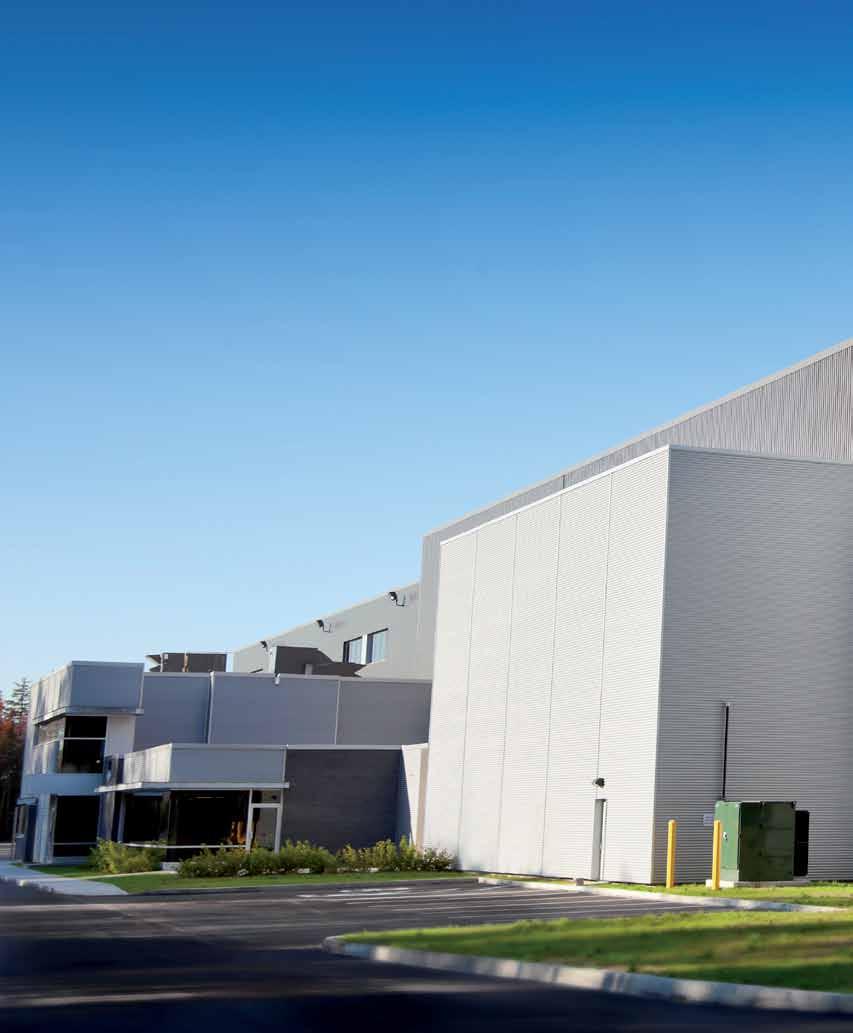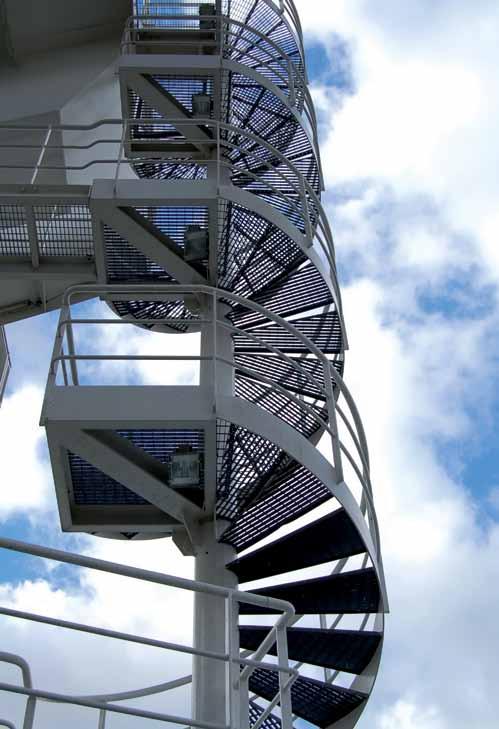HOT-DIP
GALVANIZING
TABLE OF CONTENT
The company
3
Affiliations
4
Mission & values
5
Services Specialties
7 7
Research & Development
7
Seminar
8
Hot-dip galvanizing
10
Sustainable development
17
Technical information
19
Design
21
Prevent distortion
26
Post-galvanizing treatments
27
THE COMPANY With over 40-years experience in hot-dip galvanizing and a solid commitment towards its customers, Corbec inc. has become the leading galvanizer in central and eastern Canada.
Our two installations, conveniently located in the east-end of Montreal and in Quebec City, are equipped with kettle sizes allowing for the galvanizing of a wide range of steel products, such as: • • • • •
Engineered structures such as bridges, wind mills, electrical towers, etc. Exposed architectural steel structures Fences and farming equipment Original Manufactured Equipment (OEM) A variety of metal pieces and hardware
For many years, Corbec participates and is involved with galvanizing associations as well as technical and engineering societies throughout the world. Operations staff and management are up to date on developing technologies and general improvements in our industry.
3
Our coatings are in conformity with international standards and our turn-around time will respect your tightest schedules.
4
AGA – American Galvanizers Association. www.galvanizeit.org ICCA – Canadian Institute of Steel Construction. www.icca.ca OIQ – Ordre des Ingénieurs du Québec. www.oiq.qc.ca ACRGTQ – Association des constructeurs de routes et grands travaux du Québec. www.acrgtq.ca
MISSION AND VALUES
Corbec Galvanizing the standard… As a leading hot dip galvanizer, we are committed to offering consistently superior quality, at a competitive price with reliable service. Our excellence is built on employee expertise and our ability to surpass industry expectations.
5
Corbec builds on its skills… With a view to becoming the leader in the Canadian market, Corbec will expand to meet emerging needs. To facilitate the implementation of its management model, Corbec will promote participative management and knowledge transfer. In the interest of remaining a leading-edge and innovative company, Corbec is committed to maintaining its involvement in research and development and enabling its employees to develop new capabilities.
Corbec Our values... Corbec has built a reputation for reliability founded on its fundamental values, which the company has imparted to its employees, suppliers and other business partners.
AFFILIA
6
ATIONS
FAIRNESS OPEN-MINDE DNESS R ELIABILITY C OOPERATION E FFICIENCY
SERVICES SPECIALTIES R&D SERVICES OFFERED 7
• • • •
Packing according to specifications Timelines and deadlines according to your needs (advanced production scheduling) Fast delivery (upon request) Technical support
OUR SPECIALTIES • Galvanizing process for bent rebar • Galvanizing large parts • Trailer galvanizing
RESEARCH AND DEVELOPMENT Our research and development department works in conjunction with our client projects to develop new procedures and methodology adapted to their needs. We also work with specifier’s such as Ministère des Transports du Québec and Hydro Québec to improve contracts and specifications.
SEMINARS 8 Corbec is pleased to offer training seminars, tailored to the needs of your production and design teams. At your offices or ours this activity will be customized for the size and goals of your group. Also, you can address your own set of questions prior to the seminar and we will prepare a presentation where your concerns will be at the forefront. Seminars are typically one to four hours and include an overview of the hot-dip galvanizing process. Seminars can, at your request, include a tour of one of our plants. Your team will be able to see, up-close, the production process and better understand the details surrounding hot-dip galvanizing. This activity sounds interesting? Please contact our coordinator of sales & marketing at 514-364-4000 or send a written request to reception@corbec.net.
HISTORY OF GALVANIZING
9
Hot-dip galvanized steel has been effectively used for more than 150 years. The value of hot-dip galvanizing stems from the relative corrosion resistance of zinc, which, under most service conditions, is considerably better than iron and steel. In addition to forming a physical barrier against corrosion, zinc, applied as a hot-dip galvanized coating, cathodically protects exposed steel. Furthermore, galvanizing for protection of iron and steel is favoured because of its low cost, the ease of application, and the extended maintenancefree service it provides.
HOT-DIP GALVANIZING
Galvanic Series of Metals CORRODED END (Anodic or less noble) Magnesium Zinc Aluminium Cadmium Steel Lead Tin Nickel Brass Bronzes Copper Nickel-Copper Alloys Stainless Steels (passive) Silver Gold Platinum
10
Protected End
(Cathodic or more noble)
Processus de galvanization
Galvanization process
Caustic Cleaning
Rinsing
Pickling
Rinsing
Flux Solution
Drying
Zinc bath
Cooling and Finition
What is hot-dip galvanizing Hot-dip galvanizing is a metallurgical bond between steel and molten zinc, produced in specific installations and under controlled conditions. The process, of molecular adhesion between two metals is unique and simple, yet provides excellent molecular adherence and cathodic protection.
THE ADVANTAGES
Galvanizing provides great resistance Once the freshly cleaned material is submerged in the molten zinc bath @ 450C (840 degrees F), a metallurgical bond is created composed of inter-metallic layers and a pure zinc layer.
The first inter-metallic layer is actually harder than the base steel. This quality is what gives galvanized steel its great impact and abrasion resistance. The soft, pure zinc layer helps absorb some of the shock and the inter-metallics protect the base material.
11
Microphotography of metallic coating Coat ETA 100% Zn Index of hardness 70 DPN Coat Zeta 94% Zn 6% Fe Index of hardness 179 DPN Coat Delta 90% Zn 10% Fe Index of hardness 244 DPN Coat ETA 100% Zn Index of hardness 70 DPN Coat Gamma 75% Zn 25% Fe Base steel Index of hardness159 DPN
Hot-Dip Galvanized Steel’s Estimated Service Life in Soil Hot-Dip Galvanized Steel’s Estimated Service Life in Soil High Chlorides (>20 PPM) Low Moisture (<17.5%)
pH=9.4 H 2O=5.0%
Service life (years)
250
300
200
pH H 2O
150
pH=6.6 H 2O=17.5%
100
High Chlorides (>20 PPM) High Moisture (<17.5%)
250
pH=7.9 H 2O=10.5%
pH H 2O
Service life (years)
300
200 150
pH=8.6 H 2O=17.6%
100
pH pH=7.4 H 2O=26.8% H 2O pH H 2O
50
50
pH=6.0 H 2O=40.0%
0 1.0
2.0
3.0
4.0
5.0
0 1.0
6.0
2.0
Zinc Coating Thickness (mils) Low Chlorides (<20 PPM) High Moisture (>7.0)
300
4.0
5.0
6.0
Low Chlorides (<20 PPM) Low Moisture (<7.0)
pH=7.0H 2O=5.0%
250 pH H 2O
200
pH=7.8 H 2O=19.3% pH H 2O
150 100
pH=7.0 H 2O=40.0%
Service life (years)
Service life (years)
300
pH=9.0 H 2O=5.0%
250
3.0
Zinc Coating Thickness (mils)
200
pH H 2O
150
pH=6.0 H 2O=19.4%
100
pH H 2O
50
50
pH=5.0 H 2O=40.0%
0 1.0
2.0
3.0
4.0
5.0
6.0
Zinc Coating Thickness (mils) Service life is defined as the time to necessary part replacement or underground maintenance.
0 1.0
2.0
3.0
4.0
Zinc Coating Thickness (mils) 3 1 mil=25.4 pm=056 oz/ft
5.0
6.0
12
HDG coatings have a foreseeable service-life Coating service-life is foreseeable as long as climate conditions - in which the coatings are exposed - are known. The ASTM has published the results of a research conducted in different environments where zinc coatings could be exposed to a variety of climate conditions.
13
Time to First Maintenance* (years)
100 90 80 Key
70
Rural
60
Suburban Temperate Marine
50
Tropical Marine
40
Industrial
30 20 10 0 1. 0
1.5
2.0
2.5
3.0
3.5
Average Thickness of Zinc (mils)
4.0
4.5
5.0
1 mil = 25.4μm = 0.56oz/ft2
*Time to first maintenance is defined as the time to 5% rusting of the steel surface.
Rust takes its toll on painted surfaces Here is what happens to painted steel when scratched…The exposed steel corrodes and forms a rust « bubble ». This “bubble”, larger than the surface occupied by the steel will expand and lift the paint off the surface, creating a blister. In the meantime, the cavity of corrosion and the blister continue to progress.
Zinc coating
Steel discovered is protected
Base steel
14
Galvanizing offers sacrificial protection Here is what happens in the case of galvanized steel when scratched…Thanks to its galvanic protection, the zinc coating sacrifices itself to protect the steel to which it is bonded. This sacrificial protection will prevail as long as zinc is within proximity.
Should the hot-dip galvanized coating be damaged or scratched, the steel will find protection against corrosion thanks to the surrounding zinc that has higher electrochemical properties than those of steel. Since corrosion is an electrochemical process, it will attack the surrounding zinc rather than the exposed steel. Thus said, contrary to other types of processes claiming to corrosion protection, it is not required to touch-up noticeable cracks, flaws or gaps on galvanized coatings.
Conventional Current Electrons
External Circuit
Cathode
Electrons
Anode
Electrolyte
Figure 1 : Bi-metallic couple
Galvanizing is a 15
Studies have shown that HDG is highly competitive when it comes to cost-comparison as a whole: each type of coating product has its set of characteristics to battle corrosion (and ultimately protect steel). However, these products often entail particular application, as well as relative life-span and relative savings.
cost-efficient process When compared to other types of products labeled anti-corrosive and subject to environmental standards, HDG costs have risen at a slower pace: Initial HDG costs are competitive with the costs of other products. Life-cycle cost analysis show that HDG is a wise investment compared to other products simply by considering the low/no-maintenance costs required over the project’s life-span.
Please consult the calculation tool to compare the costs of galvanization against other available protection systems online at the American Galvanizers Association website by visiting : www.galvanizingcost.com
16
SUSTAINABLE DEVELOPMENT
Hot-dip galvanizing is a responsible choice. • Raw materials are preserved because steel does not corrode, therefore, no spending is incurred for the usual recycling of scrap metal; • Nearly maintenance free, HDG cannot be compared to paint-protection: in this case, protection is a thin barrier that, once broken, is an open door to corrosion. Galvanizing helps maintain steel’s structural integrity and saves taxes when prescribed for public construction; • Very little metal is re-introduced in the environment and when recycling occurs, the energy used to melt zinc is inversely related to the amount of zinc recycled.
LCA of galvanized steel
17
Raw Material & Energy Inputs
Inputs for Maintenance = 0
Energy Inputs
Production
Use
End-of-Life
Steel Zinc Metal Galvanizing Process
Bridges Light Poles Parking Garages Truck Frames Sign Structures
Émissions 2
CO SO2 etc.
Zinc Corrosion Products
Steel & Zinc Recycle Loop (100%) For all but the most aggressive, corrosive environmental conditions, there are no energy or raw material inputs during use (75 + years). For hot-dip galvanized steel, naturally occurring zinc oxide, zinc hydroxide, and zinc carbonate.
Think about it… Zinc is a natural and vital substance. Galvanizing does not modify the environment’s balance. Whether it be nutritional supplements, sunscreens, medication or diaper creams, all contain beneficial amounts of zinc, primarily in the form of zinc oxide. The industry generally works towards the promotion of sustainable development by ensuring that its production and use is in harmony with the natural environment and the needs of society. Corbec Corporation is the first galvanizing company in Canada to fully process all polluted airs from its installations. Our newly installed energy efficient covers also contribute to the health and security of our workers.
Zinc Production Energy Input
Energy Input Energy Input
Zinc Ore from Mines (raw material)
Emissions Solid Waste
Zinc Concentration
Other Refined Primary Metals (Cu, Cd, Etc.) Emissions (SO 2, CO 2, Etc.) Solid Waste
Zinc Refining
Zinc EAF Dust End-of-Life Recycling Automobiles, appliances, galvanizied products, etc. Recycled Process Residues Skimmings and dross from galvanizing process
Zinc Metal Ingots (Ready for galvanizing kettle)
Recycled Sulphuric Acid Emissions (CO2 )
18
Hot-Dip Galvanizing The final step to determining the LCA production phase for hot-dip galvanizing is to evaluate the energy demands and emissions generated by the hot-dip galvanizing process itself. The gate-to-gate study considers the additional energy and emissions of the process beyond the inputs of the steel and zinc. Figure 10 below depicts the additional products and enegy required to coat the steel with zinc. Figure 10
Energy Input Cleaning Materials acids, water, flux Steel Product energy inputs counted in steel production
Energy Input Surface Preparation degreasing, pickling, and fluxing
Recycled Sulphuric Acid Wastes (solid, acid) Emissions ( CO 2 , acid mist) Zinc Metal Ingots energy inputs counted in zinc production
Energy Input
Galvanizing Kettle
Emissions (CO 2 )
HDG Steel Product ready for use
Recyclable Process Residus skimmings, dross in zinc production Zinc metal production and oxides into cosmetics, tires, etc.
TECHNICAL INFORMATION
Steel Selection For an optimal coating, steel has to be selected wisely. Following information is based on ASTM A 385. Generally, galvanized coatings are chosen for their anti-corrosive properties, not for their appearance. The relative corrosion resistance of the normal or abnormal coating is, in all considerations, equal. Types of zinc coatings
Type of coating zinc
1 mil
19
Metallized
Hot-Dip Galvanized
Zinc Paint
Galvanized Sheet
Electroplated
STEEL SELECTION 4 basic elements that can affect the galvanized coating: 1. Carbon in excess of about 0.25% 2. Silicon in the range of 0.04% to 0.15% or above 0.22% can produce galvanized coating growth rates much higher than those for steels with silicon levels below 0.04% and between 0.15% and 0.22%. 3. Phosphorus in excess of 0.04% 4. Manganese in excess of about 1.3% ETA (100% Zn) 70 DPN hardness ZETA (94% Zn 6% Fe) 179 DPN Hardness DELTA (90% Zn 10% Fe) GAMMA (75% Zn 25% Fe) 250 DPN hardness BASE STEEL 159 DPN Hardness
Fig. 1 Photomicrograph of Normal Galvanized Coating
Zinc Grip (Arbitrary Unit)
9 8 7 6 5 4 3 2 1 A 0
Dispersion zone values related to different authors
B
0
0,1 0,04
20
C 0,2
0,3
0,4
0,15
0,5
0,6
Si (Mass %) a Silicon effect
Coating Thickness (um)
400
Coating Thickness (um)
350
400
300 250
300
200 150
200
100 50
100
A 0
B 0,05
C 0,1 0,12
0,15
b Phosphorus Effect
0
0,2 P (Mass %)
A 0,05
B 0,1 0,09
0,15
C 0,2
0,25
0,3
Si + 2,5 (Mass %)
c Combined effect of silicon and phosphorus
CONCEPTION Vent and draining holes Thicker coating at weld due to higher silicon content of weld metal
Weld splatter will be galvanized into the coating and should be removed during fabrication to avoid unsightly appearance.
Zinc drips off causing spikes (dags) and a very rough surface
21 Combination of good drainage angles
Natural drain to one point Combination of good and bad drainage angles
Size of fame and head height of hoists affect quality of drain
Multiple hanging points for best drainage angles
On immersion, the air travels up the underside surfaces causing air pockets at each plate
On withdrawal, zinc travels or flows down the upper surfaces, pooling at each plate
22
There will always be air or zinc traps even on channels.
Angles
crop plates before welding Remember, where zinc pools so will flux Angle fabrications
zinc or air trap air pockets
zinc pockets
hole or cut corners
VENT HOLE CORRECT
AIR
Vent hole prevents air traps and resulting ungalvanized internal areas or even floatation
A
Optional hole position
Preferred fill/drain hole position Larger opening for faster flow of zinc into unit B
AIR
Incorrect vent hole
Trapped zinc sloshes out and runs solidify during cooling causing heavy, unsightly buildup from incorectly positioned hole
Vent hole Fill/drain hole
Correct drain hole Zinc
23
Suggested design for flanged hollow sections
Center hole drainage is not recommended
C
Vent hole
ZINC
Preferred vent hole position D
Zinc run
Optional hole position
Residual zinc
Open end or drain hole at the correct position and size E
If no lug is possible opposite holeing will be required for jigging
Open end full/drain facility
Space matching surfaces? Avoid welding units back to back.
Suggested design Do not forget to vent and drai hollow sections
Vent and drain holes too small!
24 Vent and drain hole size. Vent and drain holes that are too small in hollow sections increase immersion time and may cause unsightly excessive zinc drainage runs as the zinc freezes during the draining period.
Zinc will flow around and down circular units leaving drainage runs along units.
Chart 1. – Drainage holes for overlapping surfaces – steel thickness ≤ 1/2” (1.25 cm)
Overlapping surface po2 [cm2] Holes
Unwelded surfaces
< 16 [< 103]
None
None
> 16 et < 64 [> 103 &< 413]
3/8" [1 cm]
1" [2.5 cm]
> 64 et < 400 [> 413 &< 2580]
1/2" [1.25 cm]
2" [5 cm]
each increment of 400 [2580]
3/4" [2 cm]
4" [10 cm]
Chart 2. – Drainage holes for overlapping surfaces – steel thickness ≥ 1/2” (1.25 cm)
25
Overlapping surface po2 [cm2] Holes
Unwelded surfaces
< 16 [< 103]
None
None
> 16 et < 64 [> 103 &< 413]
None
None
> 64 et < 400 [> 413 &< 2580]
1/2" [1.25 cm]
2" [5 cm]
each increment of 400 [2580]
3/4" [2 cm]
4" [10 cm]
PREVENTING DISTORTION Bolted and welded assemblies varying in thickness can cause deformities or distorsion. This is caused by the variations in heating and cooling of the pieces. It is recommended to galvanize these structures prior to assembly. Assembly can then be completed by welding and reconditioning or by means of bolting or riveting with pre-galvanized hardware. Distortion can also occur during the release of welding stresses in the kettle. Therefore, proceed with welding within guidelines to balance out these stresses.
Reasons for distortion Distortion is almost always attributable to: • Release of existing or created stresses in the steel (welding, laminating, forming); • Expansion constraints for assemblies of varying thicknesses when galvanizing; • Assemblies requiring different immersion speeds.
26
This can be avoided by:
Folding of plate will introduce a certain amount of strentgh and reduce the possibility of distortion
• Design symmetry and proper sequencing of assembly; • A design that allows for quick immersion and withdrawal in the zinc kettle.
In thin-wall applications, when possible, use reinforcements that are omega or diamondshaped. When in doubt, request advice from your galvanizer
Large sheets can be break pressed which will reduce the distortion to smaller areas. Twisting may occure even though the measures have been taken
POST-GALVANIZING TREATMENT Although the look of galvanized steel is gaining in popularity, namely for residential applications, painting over galvanized steel is often required. Thankfully, this practice is widely used and its technique, usually mastered by paint professionals. Here is an overview of the specific conditions that need to be followed in order to proceed with post-galvanizing painting. The following content addresses surface preparation in relation to painting over galvanized steel.
27
Why paint? The first answer that comes to mind is « for the look »! Paint can simply be prescribed by the architect but, it can also serve as identification or extra protection in a hostile environment. Painting over galvanized steel is known as Duplex system
Benefits are …. • • • •
Paint acts as a protection barrier for galvanized steel; Galvanizing’s corrosion protection properties are enhanced and optimized by the application of paint; Scaling of paint is reduced thanks to the presence of the underlying galvanized steel; Galvanizing and paint together offers longer-lasting surface protection, 1.5 to 2.5 times their individual service-life.
Galvanized steel goes through a process of oxidation (or aging) that is illustrated with the help of what is called « passivation cycle »: Ellapsed time Free flowing air 02 0 - 48 h
Zinc Oxide ZnO
Moisture from rain (dew) H O2
48 h - 6 months
28
Zinc Hydroxide Zn (OH) 2 Free flowing air 02 + CO 2 6 months - 2 years
Fully developed patina Zinc Carbonate 27nCO 3 Zn(OH)2
When should paint be applied? Galvanized steel has three (3) “stages of aging” (when oxides are present) and painting can be executed at any stage, providing that the proper surface preparation is applied… • • • •
Immediately after the galvanizing treatment. When the galvanized steel is at 50% of its life span When the thickness of the galvanized sheet is ≤1mils At the first sign of rust
29
STANDARDS COMPLETE LIST OF ASTM AND CSA STANDARDS GOVERNING HOT-DIP GALVANIZING The following documents are not available on our web site. However, you can contact ASTM and purchase them directly.
A 123/A 123M-02 A143/A 143M-03 A 153/A 153M-03 A 384/A 384M-02 A 385-03 A 767/A 767M-00b A 780-01 B 6-0 D 6386-99 E 376-03 CAN/CSA G 164-M92
Specification for Zinc (Hot-Dip Galvanized) Coatings on Iron and Steel Products. Practice for Safeguarding Against Embrittlement of Hot-Dip Galvanized Structural Steel Products and Procedure for Detecting Embrittlement. Specification for Zinc Coating on Iron and Steel Hardware. Practice for Safeguarding Against Warpage and Distortion During Hot-Dip Galvanizing of Steel Assemblies. Practice for Providing High-Quality Zinc Coatings (Hot-Dip). Specification for Zinc-Coated (Galvanized) Steel Bars for Concrete Reinforcement. Practice for Repair of Damaged and Uncoated Area of Hot-Dip Galvanized Coatings. Specification for Zinc. Practice for Preparation of Zinc (Hot-Dip Galvanized) Coated Iron and Steel Products and hardware Surfaces for Painting. Practice for Measuring Coating Thickness by Magnetic Field or EddyCurrent Exam Method. Hot-dip Galvanizing of Irregular Shaped Products.
30
HEAD OFFICE Telephone: 514.364.4000 Toll free: 1 800 463.8313 Fax. : 514.365.9222
Montreal plant
Quebec plant
400 George V (corner Victoria) Lachine (Quebec) H8S 2R7
50, rue Lisbonne St-Augustin-de-Desmaures (Québec) G3A 0M6
Telephone: 514.637.7076 Fax: 514.639.4630
Telephone: 418.628.1055 Fax: 418.628.3031
Kettle size
Kettle size
6’
6’ 48’
56’ 10’6’’
12’
WWW.CORBECGALV.COM | 1 800 463.8313


